Klue Compete
The Competitive Enablement Platform
Learn More
INTRODUCING KLUE INSIGHTS
FIND OUT MORE >

How much do you know about your competitors’ customers? Beyond the basics of buyer personas, do you understand who your competitors are targeting and why?
One way to deepen your understanding is by honing in on three different areas: your competitors’ products, customers, and marketing claims.
This step-by-step explanation will help you to conduct an analysis of your competitors’ target customers.


One of the easiest ways to get a quick understanding of the type of customers your competitors are targeting is by checking out their customer list. Since customer logos equals company credibility, your competitors will often list many of their customers on the homepage.
More often than not, these lists can be found on the homepage or subpages of their website.
Companies including Optimizely, Slack, and Hubspot all have a banner directly on their homepage identifying current customers. We can speculate that these logos are the most highly recognizable companies that they have in their customer list. Names that people will recognize. It doesn’t necessarily identify who their best or target customers are, but rather a mix of both.
We recommend that you gather a list of your competitor’s top 20 clients, so you may need to do some digging past the homepage of your competitors. A list of this size will enable you to analyze and draw basic patterns about their target customers. Use the following steps to find more information of your competitors’ customers and who they are targeting.
Below is an example from Slack’s homepage.
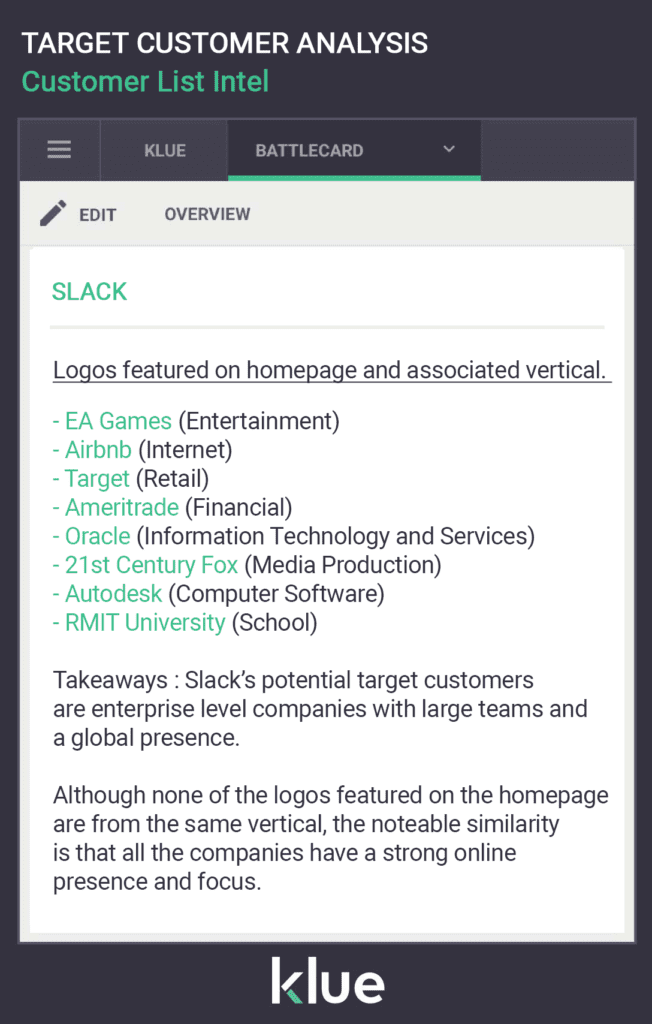

Competitor case studies are another insightful resource for gathering detailed information on your competitor’s target customers. You can guarantee that these case studies are written about clients that your competitors have built a strong relationship with and have achieved results.
Most competitor case studies can be found on the Resources page of your competitors’ website.
Here is an example of a battlecard built using the information we obtained from a Slack case study.
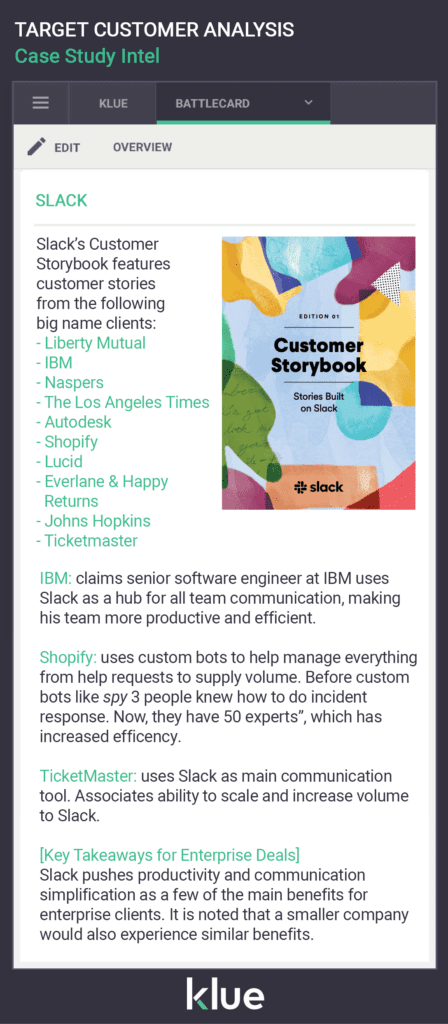

The quickest way to confirm who your competitors’ buyers are is by seeing who has reviewed them. Depending on your industry, sources like G2 Crowd, Capterra, or Trust Radius are our first choice of review sites to check out.
These review sites will give you a more in-depth understanding of the variety of clients your competitor has.
For our review site example, we’ve used a popular review site to pull out perceived key strengths and weaknesses in their product offerings.
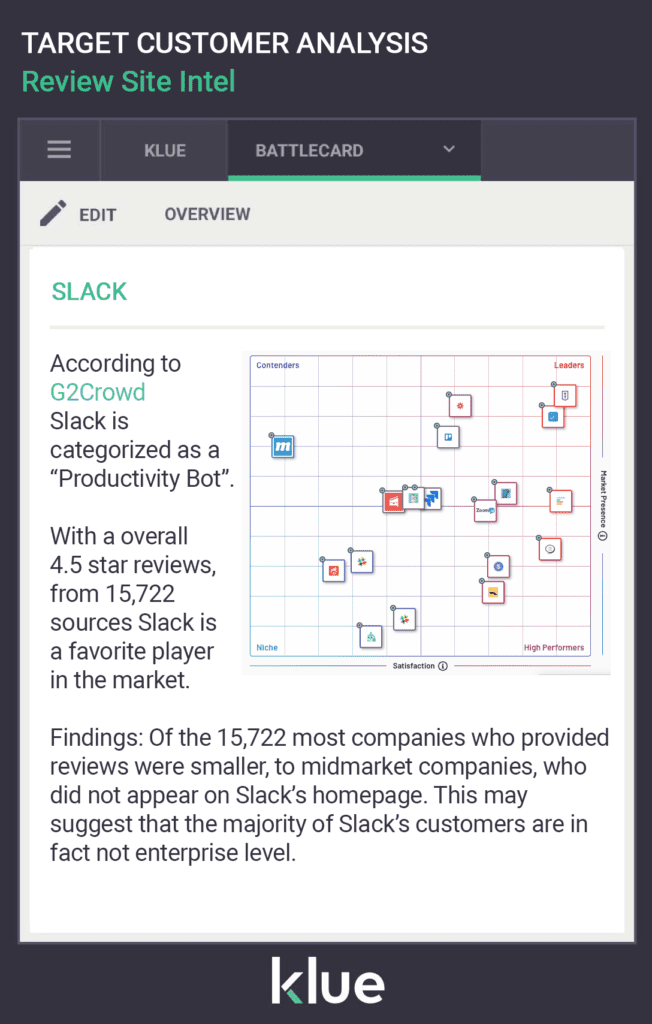

It’s important to utilize loss notes to uncover further insights on the type of customers you’re losing to a competitor. Loss notes act as a treasure map to identify what companies your direct competitors are targeting and who they win deals with.
If you’re in charge of conducting win-loss interviews we encourage you to check out our Win-Loss Template for a reminder on best practices.
Below is an example of a Loss Note battlecard for Slack.
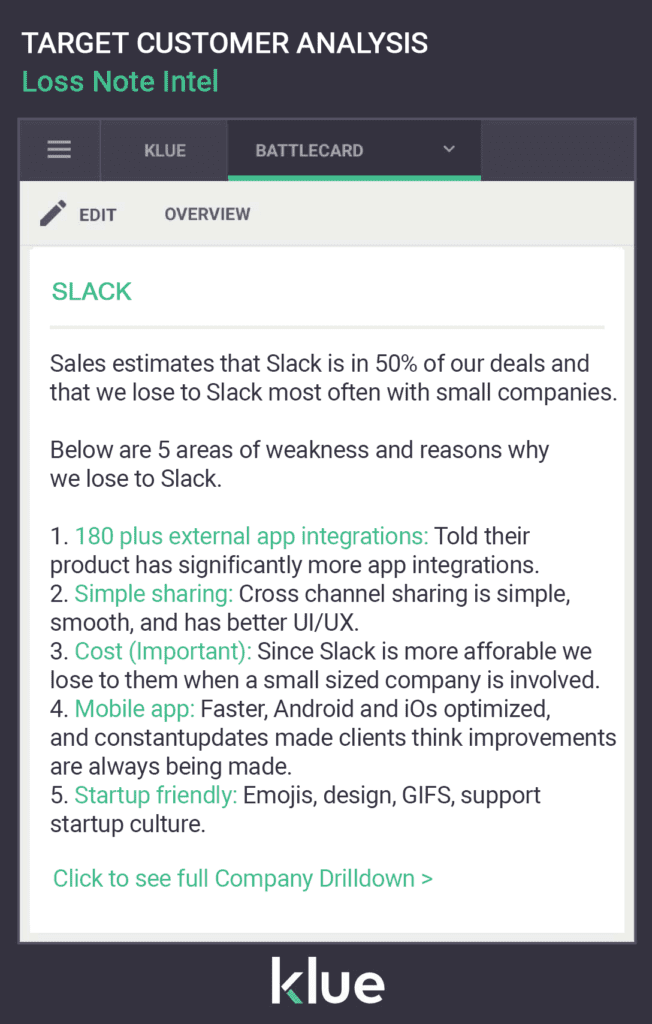

Similar to loss notes, directly interviewing your sales team is the fifth step in gathering information about your competitors’ target customers.
What you will learn is further context about your competitors directly from the perspective of your reps.
Questions to ask your sales team include:
“When [Competitor X] is already involved in a deal what type of questions are your prospects asking?”
“How does [Competitor X] deposition our product/service?”
“What types of accounts do you overlap with [Competitor X] most often?”
Here is an example of a sales interview battlecard built with information gathered from your sales team.
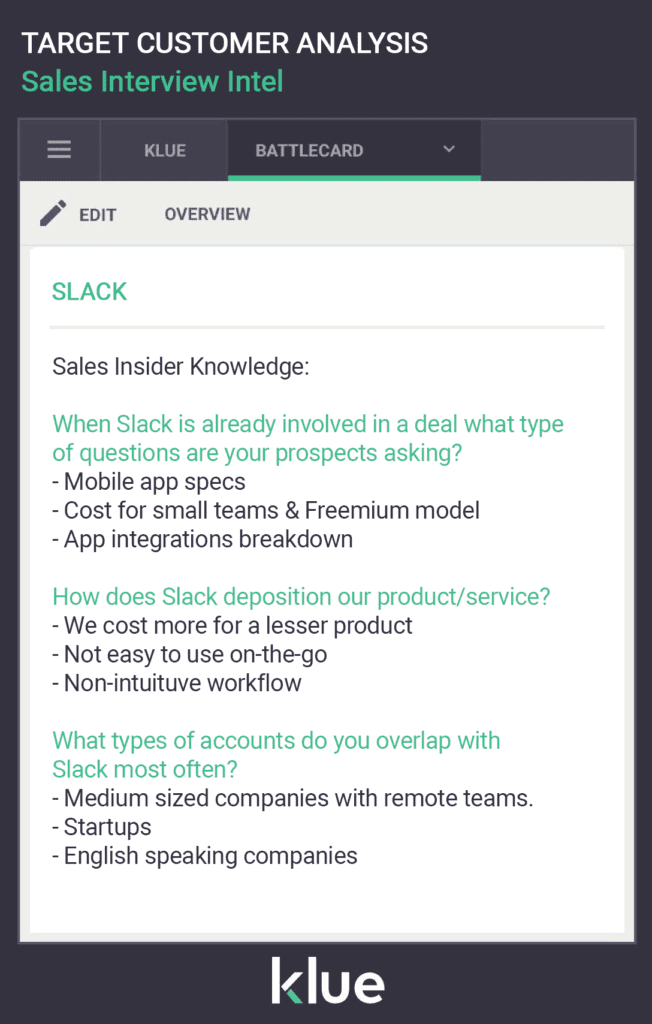

Blogs are a powerful source to identify competitors’ target customers, and how they talk to them.
Similarly to case studies, blog posts can help you understand who your competitors are writing to and what claims they are making.
Our suggestion, when analyzing blog posts, is to read through your competitors content and try to find patterns in language, subject, and material. For example, if the majority of the posts published by your competitors are about enabling communication within an enterprise organization, it would be fair to assume that your competitors are targeting enterprise-level customers.
Below is an example of a battlecard built of intel we collected from Slack’s blog.


Analyst reports, like the Gartner magic quadrant can help you better understand your competitors in a variety of ways. The quadrant itself, while interesting, doesn’t provide extensive intel. Rather, the rest of the report is where to find the more important insights.
Analyst reports will elude to what industry/vertical, size of company, and functional teams that your competitors are best suited for. This information is not always explicitly stated, so you have to read between the lines.
Here is an example of a battlecard built using a Gartner magic quadrant analyst report with information on Slack.
As mentioned in our Competitor Product Analysis Template, if you’re dealing with competitors who are selling to large public organizations, many of these organizations will publicly share details regarding the purchase of any product or marketing tool. The most common file format to find this information is a PDF.
By completing a quick Advanced Google search, you are likely to uncover intel on your competitors including key customers.
Just for a refresher, here is an example of how to perform an Advanced Google Search for PDF.
First step: In Google, click on “Settings” and then select “Advanced Search”.
Step 2- Filter your PDF search by filling in any relevant search terms.


Step 3- Once you have set parameters, scroll down and select to “file type” Choose “Adobe Acrobat PDF” as your preferred format.




Competitive Enablement
The topic of Large Language Models (LLMs) has a lot of confusion. Here's what you need to know about how Klue is working with them.


Competitive Enablement
Product Marketing
If your competitive intel game is too strong for automation, too pure for data privacy, and too rebellious for accuracy — then Klue AI is probably not for you.


Let’s do it. Tell us a bit about yourself and we’ll set up a time to wow you.
Let's do it. Tell us a bit about yourself and we'll set up a time to wow you.
XLet's do it. Tell us a bit about yourself and we'll set up a time to wow you.
XSubscribe to get our latest AI functionality and news in your inbox.
XOur Buyer Pulse feature, set to launch in Q2 2024, offers valuable insights into the factors influencing buyer decisions in your pipeline. By signing up for the waitlist, we can better gauge interest and proactively engage with you to streamline the setup and integration process before the feature becomes widely available.
X